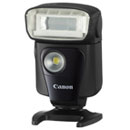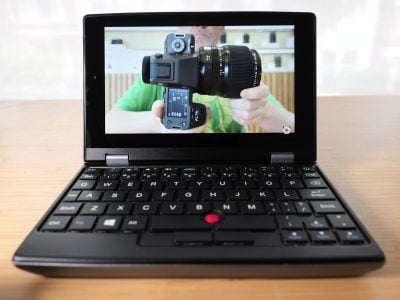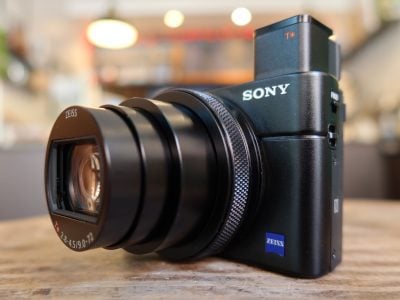Canon PowerShot G9
-
-
Written by Gordon Laing
Canon PowerShot G9 Verdict
The Canon PowerShot G9 is a very powerful compact which will greatly appeal to enthusiasts or anyone looking for a pocketable backup for a DSLR. It features a wide array of manual controls which unlike many compacts are sensibly implemented and on the whole, unrestricted. The quality lens offers a useful 6x range and sports both optical stabilisation and impressive macro facilities. On the top is a fully-featured hotshoe which supports Canon’s Speedlites (complete with in-camera control over the 580EX II) and even its wireless transmitter. And the icing on the cake is support for RAW recording.
That’s all pretty impressive stuff, but the thing which makes the G9 unique is having this degree of power and flexibility in a relatively pocketable form factor. Most manufacturers these days reserve these kind of features and manual controls for physically larger super-zoom models. So while the G9’s solid block-like design may be considerably chunkier than even average compacts, it’s crucially much smaller than any super-zoom or DSLR. The bottom line is while you may be squeezing rather than slipping it into a pocket, at least the G9 will fit in there.
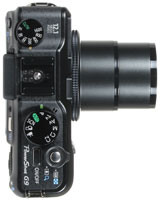 |
|
It’s not all good news though. The lens may be decent quality, but with a widest equivalent of 35mm, it’s missing out on true wide angle capabilities. The new time lapse movie mode may also be nice, but we’d have like to have seen proper widescreen video capabilities, as offered on Panasonic’s compacts for some time. And unusually for a premium compact designed for demanding enthusiasts, the G9 ain’t exactly quick in terms of power-up, AF or continuous shooting.
Then there’s the PowerShot G legacy – Canon may have reinstated RAW recording on the G9, but G-series veterans will still miss aspects like a flip-out monitor and f2.0 lens. It’s certainly a little galling you can get the G9’s sensor and a flip-out screen on the cheaper PowerShot A650 IS. Finally we should also mention while the G9 takes a sensible minimal approach to noise reduction, retaining as much detail as possible, it’s still not going to perform miracles at 400 ISO and above. Like all non-DSLRs, you’d be advised to operate it at the lowest sensitivities.
But if you want DSLR-style controls and flexibility in the smallest possible form factor, the PowerShot G9 should be high on your shortlist. The interesting thing though is how short this list could actually end up being, as there’s really little else on the market offering a similar proposition. Smaller compacts tend to have considerably fewer controls, and if you want a flash hotshoe and RAW on a non-DSLR, you’re looking at physically larger models like Panasonic’s Lumix DMC-FZ50. As such, our following ‘compared-to’ list is going to be a little shorter than normal.
Compared to Canon PowerShot G7
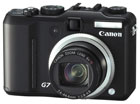 |
The closest rival to the G9 is of course its predecessor, the PowerShot G7. Both cameras feature the same optics and block-like design with only a few external differences to tell them apart. Most obviously the new G9 has a 3in screen compared to the G7’s 2.5in model. The G9 also has a slightly improved grip, but there’s still little to grab hold of.
The biggest differences are internal, with the G9 featuring two extra megapixels, RAW recording, a time lapse mode and improvements to both flash support and face detection. RAW is arguably the most important of these features and will undoubtedly be responsible for many sales including some from existing G7 owners. But the G9 is a case of evolution rather than revolution, so unless you’re a G7 owner who’s desperate for RAW and support for wireless flash, you’d probably stick with what you’ve got. New buyers should keep an eye open for discounted G7s, but since there’s little between them from most suppliers, the G9 remains the more sensible choice. See our Canon PowerShot G7 review for more details.
Compared to Panasonic Lumix DMC-LX2
 |
The Panasonic LX2 shares a number of similarities with the G9. Both are relatively pocketable high resolution cameras with optically-stabilised zooms, and a high degree of creative control which includes support for RAW. The LX2’s zoom may have a shorter 4x range, but starts at an equivalent of 28mm for decent wide-angle coverage. It additionally sports a 16:9 widescreen sensor and screen while also coming in slightly cheaper.
The LX2 sounds like a compelling rival, but doesn’t feature a flash hotshoe and is sadly let down by serious noise and noise reduction issues. The G9 is no angel in this respect either, but is definitely better, with modest noise reduction avoiding the watercolour effects of the Panasonic. If you’re willing to shoot exclusively at 100 ISO and don’t need the hotshoe, the LX2 could be worth considering for the wide angle capabilities and small form factor, but most will prefer the G9 overall. See our Panasonic Lumix LX2 review for more details.
Canon PowerShot G9 final verdict
Ultimately the PowerShot G9 may not be without its faults, but there’s simply few if any alternatives which offer this degree of control and flexibility in a pocketable form factor. There are certainly smaller compacts out there, but none have the G9’s control and options. And while there’s decent controls on (most) super-zooms and DSLRs, none will squeeze into your pocket. Indeed this could be all you need to know.
While the G9 is a powerful camera with many highlights though, potential buyers should be aware of its shortfalls. First we felt the power-up and AF speed should have been much quicker for a camera of its class and target market. The continuous shooting is also disappointingly slow, which means the G9 is better-suited to considered photography rather than action or spontaneous shots.
Secondly the lens could do with zooming wider, to an equivalent of, say, 28mm. And speaking of wide, it’d be nice to have the ability to record widescreen movies. Both widescreen video and wide angle lenses are standard on almost all of Panasonic’s compacts and make Canon look a little old fashioned.
But again you return to the fact the G9 offers probably the best manual control of any compact in a form factor you can squeeze into most pockets. Couple that with a good lens, superb build quality, respectable images at lower sensitivities, support for RAW, decent face detection, a neat time-lapse video feature, and best of all, a flash hotshoe, and you’ve got a camera which will still greatly appeal to enthusiasts. The relatively slow performance and lack of wide angle in the current climate prevent us from awarding our Highly Recommended rating, but the G9 still comes Recommended.
Ultimately there remains demand for a highly capable top-of-the-range compact, and while the PowerShot G9 misses out in some key respects, it’s still a lot closer than anything else on the market.
Good points Bad points |  Scores | |||
Build quality: Image quality: Handling: Specification: Value:
Overall: | 18 / 20 17 / 20 17 / 20 18 / 20 17 / 20
87% | |||
